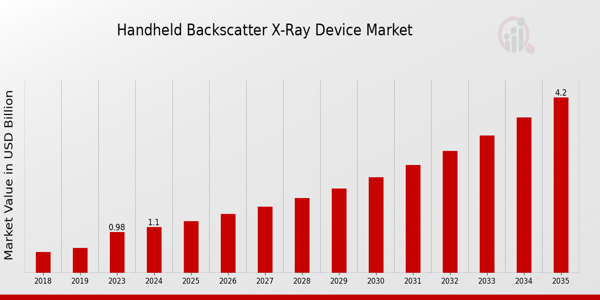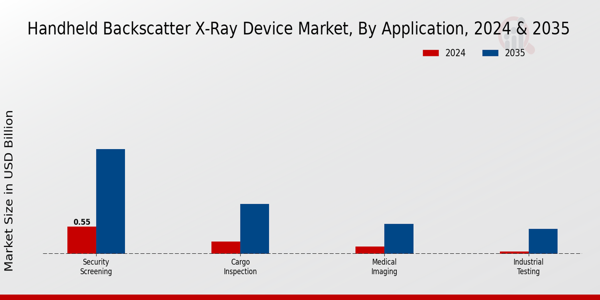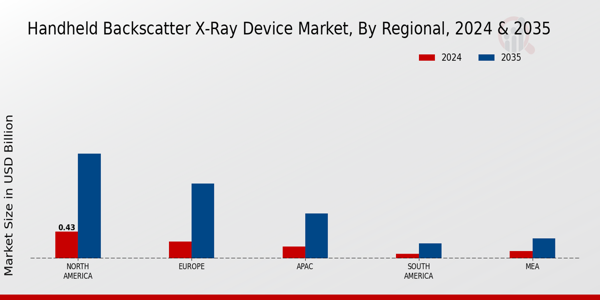Global Handheld Backscatter X-Ray Device Market Overview:
Handheld Backscatter X-Ray Device Market Size was estimated at 0.98 (USD Billion) in 2023. The Handheld Backscatter X-Ray Device Market Industry is expected to grow from 1.1(USD Billion) in 2024 to 4.2 (USD Billion) by 2035. The Handheld Backscatter X-ray device Market CAGR (growth rate) is expected to be around 12.93% during the forecast period (2025 - 2035).
Key Handheld Backscatter X-Ray Device Market Trends Highlighted
The Handheld Backscatter X-ray Devices Market is witnessing robust growth owing to increased security checks and the need for adequate screening in different premises. Due to the constantly changing threats to public safety, the market for portable, effective security solutions has rapidly increased. Non-invasive inspection offered by handheld backscatter X-ray devices makes them easy to use at airports, borders, and large venues during public events. Moreover, the improvements in technology make these devices more accurate and simpler to operate, thus ensuring that people in different industries will make use of them.
Opportunities within the market can be captured through the integration of advanced imaging technologies and artificial intelligence. As these devices become more sophisticated, they can better detect concealed items and offer real-time analysis, drawing interest from not only security organizations but also venues hosting high-profile events, law enforcement agencies, and health inspections. Partnerships with tech developers can lead to innovations that improve device portability and decrease operational costs. The incorporation of machine learning can also streamline the process of threat detection, providing operators with critical data insights. Recent trends indicate a growing emphasis on regulatory compliance and the standardization of safety measures across industries. Public awareness regarding safety and security is increasing, compelling businesses and organizations to invest in robust screening solutions. Another noteworthy trend is the rising deployment of handheld devices in non-traditional settings, such as schools and community events, thus broadening the scope of potential applications. The market is also responding to environmental concerns with more energy-efficient devices that align with sustainability goals. The future of the Handheld Backscatter X-ray device Market appears promising as these trends continue to evolve, offering significant potential for all stakeholders involved.

Source: Primary Research, Secondary Research, MRFR Database and Analyst Review
Handheld Backscatter X-Ray Device Market Drivers
Increased Security Concerns and Demand for Smarter Detection Technologies
The heightened emphasis on security across various sectors has significantly fueled the demand for advanced detection technologies, including the Handheld Backscatter X-Ray Device Market Industry. In recent years, global concerns around terrorism, smuggling, and unauthorized substances have intensified, resulting in governments and private security firms seeking state-of-the-art solutions to enhance safety measures. Handheld backscatter X-ray devices have emerged as a robust solution due to their ability to quickly and accurately identify concealed threats, such as weapons and explosives, without the need for invasive searches. These devices employ advanced imaging techniques that provide detailed insights into the contents of bags and personal items, making them essential for security personnel at airports, border control points, and large-scale events. Furthermore, their portability and ease of use facilitate rapid deployment in various environments, further strengthening their position in the market. The ongoing evolution of criminal tactics necessitates that security technologies continuously advance, thus propelling significant investments in the Handheld Backscatter X-Ray Device Market Industry. This trend is likely to continue as the market evolves, driven by not only existing security threats but also future uncertainties, emphasizing the importance of vigilance and preparedness.
Technological Advancements in Imaging Techniques
The Handheld Backscatter X-Ray Device Market Industry is experiencing rapid growth thanks to continuous technological advancements. Innovations in imaging technology have enhanced the efficacy and efficiency of handheld backscatter X-ray devices. These advancements have led to faster scanning processes, improved image resolution, and enhanced material discrimination capabilities. As technology continues to evolve, manufacturers are incorporating more sophisticated algorithms and software that allow for real-time data analysis, making it easier for security personnel to interpret results quickly.Such developments are crucial in high-paced environments where time is of the essence.
Growing Applications in Various Sectors
The applications of handheld backscatter X-ray devices are expanding beyond traditional security roles, driving the growth of the Handheld Backscatter X-Ray Device Market Industry. Sectors such as customs, law enforcement, military, and critical infrastructure security are increasingly adopting these devices for diverse operations. Their versatility allows for a wide range of uses, from screening luggage at airports to inspecting cargo containers and providing security in large gatherings.The growing applicability across multiple domains highlights the importance of these devices in ensuring safety and compliance, propelling the market forward.
Handheld Backscatter X-Ray Device Market Segment Insights:
Handheld Backscatter X-Ray Device Market Application Insights
The Handheld Backscatter X-Ray Device Market demonstrates robust growth across its wide array of applications, emphasizing its increasing significance in various industries. In 2024, the overall market was valued at 1.1 USD Billion and is projected to reach 4.2 USD Billion by 2035, reflecting a strong potential for expansion. A key application within this market is Security Screening, which is expected to hold the majority share, valued at 0.55 USD Billion in 2024 and projected to grow to 2.1 USD Billion by 2035. This application plays a pivotal role in enhancing safety measures across airports, public venues, and border security, thus driving its demand and leading its market significance.
In addition to Security Screening, Cargo Inspection is another vital application, valued at 0.25 USD Billion in 2024 and expected to increase to 1.0 USD Billion by 2035. This segment is essential in ensuring secure transportation of goods, helping to identify unauthorized or dangerous items, and thereby supporting trade security. Medical Imaging, although smaller in magnitude at 0.15 USD Billion in 2024 and increasing to 0.6 USD Billion by 2035, serves a crucial role in enhancing diagnostic capabilities, providing non-invasive methods to assess internal conditions, which is gaining traction among healthcare providers.
Finally, Industrial Testing, valued at 0.05 USD Billion in 2024 and projected to grow to 0.5 USD Billion by 2035, also contributes to the market. This application focuses on examining materials for structural integrity and safety, which is particularly important in the manufacturing and construction sectors. Overall, the Handheld Backscatter X-Ray Device Market segmentation highlights varying dynamics where Security Screening dominates, but each segment plays its part in promoting safety and efficiency across different fields, underscoring the rising importance and market demand of these devices across various real-world applications. Each application not only represents significant financial values but also reflects growing trends that support increased investment and development within the industry.

Source: Primary Research, Secondary Research, MRFR Database and Analyst Review
Handheld Backscatter X-Ray Device Market End-Use Insights
The Handheld Backscatter X-ray device Market, achieved a valuation of 1.1 USD Billion in 2024, showcases a diverse End-use landscape that encompasses various sectors such as Government Agencies, Transportation, Healthcare Facilities, and Manufacturing. Each of these sectors plays a pivotal role in driving the demand for handheld backscatter X-ray devices due to their unique operational needs. Government Agencies are increasingly adopting these devices for security purposes, enhancing surveillance measures through their portability and efficiency. In the Transportation sector, the need for rapid and thorough security checks at various transit points propels the adoption of these x-ray devices, ensuring safety and compliance. Healthcare Facilities also leverage handheld backscatter X-ray technology, providing the ability to conduct non-invasive scans that streamline patient care. Meanwhile, the Manufacturing industry utilizes these devices for quality control, helping in the detection of flaws in materials. Hence, the Handheld Backscatter X-ray device Market segmentation illustrates a well-balanced demand across multiple sectors, each contributing significantly to the overall growth and market statistics.
Handheld Backscatter X-Ray Device Market Scanning Type Insights
The Handheld Backscatter X-ray device Market, specifically within the Scanning Type segment, is a crucial area of interest, projected to be valued at 1.1 billion USD by 2024. This segment comprises various scanning technologies, with Portable Scanners, Mobile Scanners, and Fixed Scanners playing significant roles. Portable Scanners are essential for on-the-go inspections, making them highly appealing for security applications in airports and large events. Mobile Scanners offer flexibility and can be utilized in various environments, enhancing operational efficiency, while Fixed Scanners are generally deployed in stationary setups for consistent, high-quality imaging. The increasing demand for security and safety inspections globally fuels the market growth, while advancements in technology contribute to enhanced scanner capabilities. Major growth drivers include rising security concerns and regulatory mandates that necessitate thorough inspections across different sectors. Notably, the Portable Scanners segment is witnessing a notable rise due to their ease of use and capability to operate in diverse locations. The overall Handheld Backscatter X-Ray Device Market data reveals a competitive landscape with opportunities for innovation and improvement in detection technologies, setting the stage for significant future developments in the industry.
Handheld Backscatter X-Ray Device Market Technology Insights
The Handheld Backscatter X-Ray Device Market reached 1.1 USD Billion in 2024 and grew notably to 4.2 USD Billion by 2035. In terms of technology segmentation, Backscatter X-ray technology plays a critical role, primarily due to its efficiency in detecting concealed threats, making it pivotal for security applications. Computed Tomography, while more complex, offers significant advantages in imaging accuracy, allowing for detailed internal assessments, which enhances its importance within the healthcare sector. Meanwhile, Dual Energy X-Ray Technology is gaining traction for its ability to differentiate between materials, offering invaluable insight into various fields. The interplay of these technologies drives the overall market growth, presenting opportunities that cater to security, healthcare, and industrial applications by providing robust detection capabilities and facilitating enhanced imaging solutions. Market trends indicate a rising demand for portable and efficient imaging solutions, challenging providers to innovate continually while addressing regulatory requirements and safety concerns in their development processes.
Handheld Backscatter X-Ray Device Market Regional Insights
The Handheld Backscatter X-ray device Market exhibits significant regional variations, with North America leading in market value, holding a valuation of 0.432 USD Billion in 2024, projected to rise to 1.696 USD Billion by 2035. This region dominates due to heightened security measures and technological advancements. Europe follows with a valuation of 0.275 USD Billion in 2024, growing to 1.212 USD Billion by 2035, driven by increasing regulations and safety standards. The APAC region, though currently valued at 0.196 USD Billion in 2024, is expected to see substantial growth, reaching 0.727 USD Billion by 2035 as nations bolster their security infrastructure.South America and the MEA regions, valued at 0.079 USD Billion and 0.118 USD Billion, respectively, in 2024, are smaller yet show potential for moderate growth, with valuations of 0.242 USD Billion and 0.323 USD Billion predicted by 2035. The regional dynamics highlight varying growth drivers, with North America and Europe showcasing majority holding due to established sectors, while APAC is emerging rapidly, presenting opportunities driven by security enhancements. The Handheld Backscatter X-Ray Device Market revenue reflects these diverse regional landscapes, illustrating the broader trends and challenges impacting industry growth.

Source: Primary Research, Secondary Research, MRFR Database and Analyst Review
Handheld Backscatter X-Ray Device Market Key Players and Competitive Insights:
The Handheld Backscatter X-Ray Device Market is characterized by a dynamic competitive environment driven by the increasing demand for advanced security screening technologies across various sectors, such as transportation, border security, and public safety. This market involves a range of players, including established manufacturers and emerging companies that are continuously innovating to enhance the performance and capabilities of handheld backscatter X-ray devices. Competitive strategies typically focus on product development, strategic partnerships, and expanding market reach through geographical diversification. Furthermore, regulatory requirements and technological advancements play a crucial role in shaping the competitive landscape, compelling companies to invest in research and development to stay ahead in this rapidly evolving sector. Nuctech holds a prominent position in the Handheld Backscatter X-ray device Market thanks to its robust portfolio of innovative security solutions that cater to diverse applications. The company has built a reputation for delivering high-quality and reliable products that meet stringent international safety standards. Nuctech's strengths lie in its advanced technological capabilities and dedication to research and development, enabling the introduction of sophisticated features in its handheld devices. The company also benefits from a strong global presence, allowing it to cater to a wide range of customers spanning multiple continents, which enhances its competitive edge. Furthermore, Nuctech is known for its strong customer service and support, fostering long-term relationships with clients and contributing to customer loyalty. Bruker is another key player in the Handheld Backscatter X-ray device Market, recognized for its commitment to scientific excellence and innovation. The company specializes in high-precision measurement equipment, with its handheld backscatter X-ray devices drawing interest for their cutting-edge instrumentation and analytical capabilities. Bruker's strengths include their emphasis on research and innovation, which equips their devices with the latest technology, providing users with high sensitivity and specificity in detecting materials. The firm has also cultivated a strong brand reputation in various analytical and safety sectors, reinforcing confidence among customers in the reliability and effectiveness of its products. Additionally, Bruker's global distribution network and strategic partnerships allow it to effectively reach various markets, further solidifying its competitive position in the handheld backscatter X-ray landscape.
Key Companies in the Handheld Backscatter X-Ray Device Market Include:
- Nuctech
- Bruker
- Molex
- MST Global
- ALBIS
- L3 Communications
- COVIA
- Scanna MSC
- Xray Imaging Corp
- Zecotek Photonics
- Astrophysics Inc
- Leidos
- Smiths Detection
- Varex Imaging
Handheld Backscatter X-Ray Device Market Industry Developments
Recent developments in the Global Handheld Backscatter X-ray Device Market reveal a surge in demand for advanced security technologies fueled by growing concerns over safety and effective threat detection. Companies such as Nuctech and Smiths Detection are intensifying their efforts in R&D to enhance imaging capabilities, while Bruker and ALBIS focus on improving the portability and ease of use of their devices. In terms of mergers and acquisitions, significant activities such as partnerships and collaborations among key players like L3 Communications and Astrophysics Inc. have been observed, driving innovation and expanding market reach. Notably, recent valuations for firms like Varex Imaging and Scanna MSC suggest a positive trajectory, reinforcing their competitive positioning in the market. The increasing emphasis on border security and airport screening processes is likely to catalyze further growth and investment in advanced handheld backscatter x-ray technologies, enabling companies to capture larger market shares and enhance operational efficiencies. As the industry evolves, the landscape remains dynamic with ongoing technological advancements that aim to address both governmental and commercial security needs effectively.
Handheld Backscatter X-Ray Device Market Segmentation Insights
Handheld Backscatter X-Ray Device Market Application Outlook
- Security Screening
- Cargo Inspection
- Medical Imaging
- Industrial Testing
Handheld Backscatter X-Ray Device Market End-Use Outlook
- Government Agencies
- Transportation
- Healthcare Facilities
- Manufacturing
Handheld Backscatter X-Ray Device Market Scanning Type Outlook
- Portable Scanners
- Mobile Scanners
- Fixed Scanners
Handheld Backscatter X-Ray Device Market Technology Outlook
- Backscatter X-Ray Technology
- Computed Tomography
- Dual Energy X-Ray Technology
Handheld Backscatter X-Ray Device Market Regional Outlook
- North America
- Europe
- South America
- Asia-Pacific
- Middle East and Africa
| Attribute/Metric Source: |
Details |
| MARKET SIZE 2023 |
0.98(USD Billion) |
| MARKET SIZE 2024 |
1.1(USD Billion) |
| MARKET SIZE 2035 |
4.2(USD Billion) |
| COMPOUND ANNUAL GROWTH RATE (CAGR) |
12.93% (2025 - 2035) |
| REPORT COVERAGE |
Revenue Forecast, Competitive Landscape, Growth Factors, and Trends |
| BASE YEAR |
2024 |
| MARKET FORECAST PERIOD |
2025 - 2035 |
| HISTORICAL DATA |
2019 - 2024 |
| MARKET FORECAST UNITS |
USD Billion |
| KEY COMPANIES PROFILED |
Nuctech, Bruker, Molex, MST Global, ALBIS, L3 Communications, COVIA, Scanna MSC, Xray Imaging Corp, Zecotek Photonics, Astrophysics Inc, Leidos, Smiths Detection, Varex Imaging |
| SEGMENTS COVERED |
Application, End Use, Scanning Type, Technology, Regional |
| KEY MARKET OPPORTUNITIES |
Increased demand for security solutions, Growth in border control technologies, Adoption in public safety inspections, Expansion in defense applications, Rising need for non-invasive scanning |
| KEY MARKET DYNAMICS |
Rising security concerns, Increasing airport scans, Technological advancements, Regulatory compliance pressures, Growing adoption in law enforcement |
| COUNTRIES COVERED |
North America, Europe, APAC, South America, MEA |
Frequently Asked Questions (FAQ) :
The market is expected to be valued at 1.1 USD Billion in 2024.
By 2035, the market is projected to reach a value of 4.2 USD Billion.
The expected CAGR for the market during this period is 12.93%.
The Security Screening segment holds the largest market share, valued at 0.55 USD Billion in 2024.
The Cargo Inspection segment is expected to be valued at 1.0 USD Billion by 2035.
North America is expected to dominate the market, valued at 1.696 USD Billion in 2035.
In 2024, the market size in Europe is valued at 0.275 USD Billion.
Key players in the market include Nuctech, Bruker, Molex, and Smiths Detection among others.
The market size for Medical Imaging is expected to be 0.6 USD Billion in 2035.
The Industrial Testing segment is valued at 0.05 USD Billion in 2024.

















